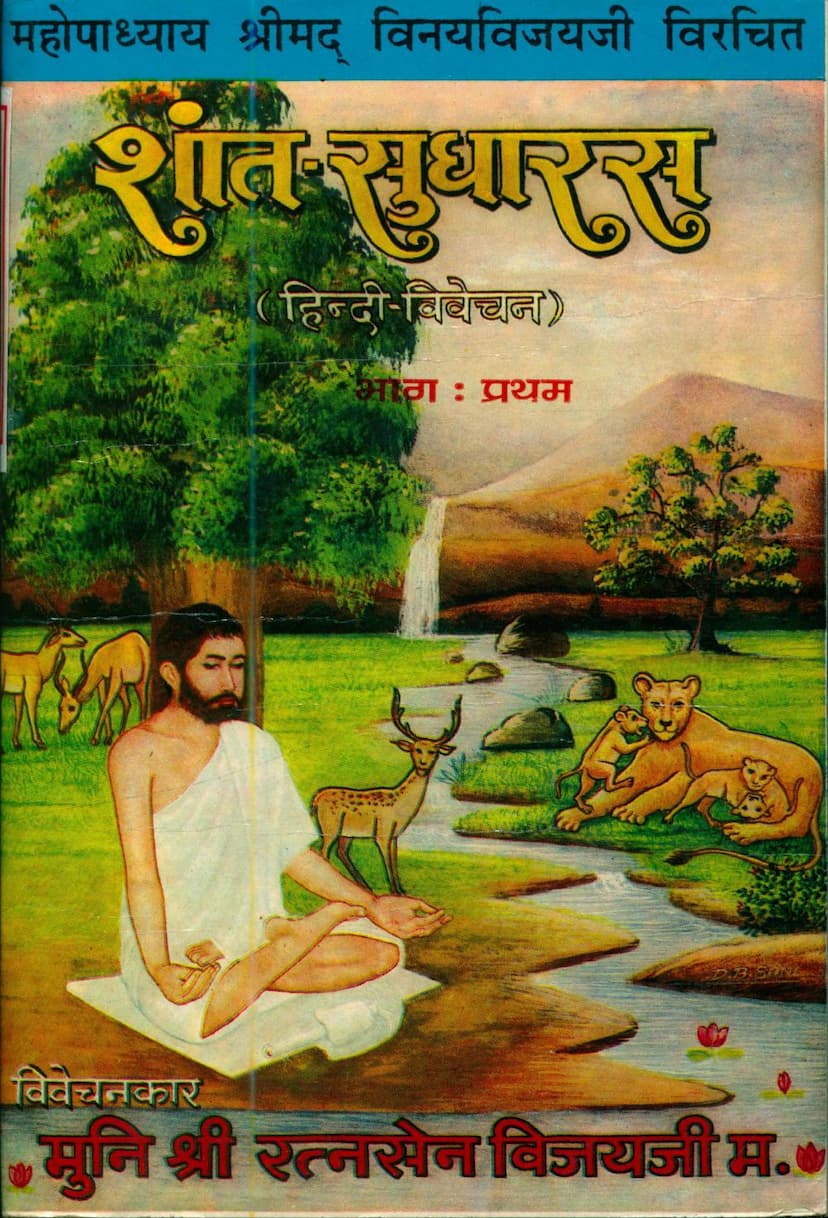Shant Sudharas Part 01
Added to library: September 2, 2025

Summary
Here's a comprehensive summary of the Jain text "Shant Sudharas Part 01" by Ratnasenvijay, based on the provided pages:
Book Title: Shant Sudharas Part 01 (शांत सुधारस भाग: प्रथम) Author of Original Work: Mahopadhya Shrimad Vinayvijayji (महोपाध्याय श्रीमद् विनयविजयजी) Commentator/Elucidator: Muni Shrimad Ratnasen Vijayji (मुनि श्री रत्नसेन विजयजी म.) Publisher: Swadhyay Sangh (स्वाध्याय संघ)
Overall Purpose: "Shant Sudharas Part 01" is the Hindi commentary and elaboration by Muni Ratnasen Vijayji on the original Sanskrit work "Shant Sudharas" by Mahopadhya Vinayvijayji. The original work is a poetic treatise expounding the Sixteen Bhavanas (meditations/contemplations) crucial for spiritual progress in Jainism. The commentary aims to make these profound teachings accessible to a Hindi-speaking audience.
Key Themes and Content:
-
Dedication and Gratitude: The book begins with a dedication by Muni Ratnasen Vijayji to his spiritual preceptor, Panyasvar Shrimad Bhadrakar Vijayji Ganivarya Shri, expressing profound respect and gratitude.
-
The Essence of "Shant Sudharas":
- The title "Shant Sudharas" itself translates to "Nectar of Peace" or "Essence of Tranquility."
- The work focuses on the Sixteen Bhavanas (meditations) which are considered essential for cultivating inner peace and spiritual awakening.
- The commentator emphasizes that these meditations help to curb negative tendencies like attachment (raag) and aversion (dwesh), leading to a state of equanimity.
-
The Original Work by Mahopadhya Vinayvijayji:
- Mahopadhya Vinayvijayji was a renowned scholar and poet. His original work, "Shant Sudharas," is praised for its lyrical and devotional quality, comparing it to Jayadeva's "Gita Govinda" in its aesthetic appeal.
- The original text is described as a vast ocean of the "Shant Ras" (the sentiment of peace and serenity), considered the king of all sentiments in Indian aesthetics.
- The commentator highlights Mahopadhya Vinayvijayji's profound understanding of Jain philosophy and his ability to convey deep spiritual truths through beautiful poetry.
- The pages also provide an extensive list of Mahopadhya Vinayvijayji's other scholarly works, covering grammar, philosophy, cosmology, and devotional literature, showcasing his immense contribution to Jain literature.
-
The Commentary by Muni Ratnasen Vijayji:
- Muni Ratnasen Vijayji is lauded for his diligent effort in translating and elaborating the original Sanskrit text into simple, lucid, and engaging Hindi.
- His commentary is characterized by the use of analogies, examples, and stories (both ancient and modern) to make the complex philosophical concepts relatable and understandable.
- The commentator's background as a capable preacher and translator of significant Jain works is highlighted, emphasizing his ability to connect with the audience and inspire spiritual progress.
- He aims to fulfill the suggestion of making the teachings of "Shant Sudharas" available to the wider Hindi-speaking community.
-
The Sixteen Bhavanas:
- The text explains that these sixteen meditations are divided into two groups:
- Twelve Bhavanas: Anitya (Impermanence), Asharan (Unprotectedness), Sansar (Cycle of Birth and Death), Ekattva (Aloneness), Anyattva (Otherness), Shuchi (Impurity), Asrav (Inflow of Karmas), Samvar (Stoppage of Karmas), Nirjara (Shedding of Karmas), Dharma (Righteousness), Lok (The Universe), and Bodhi Durlabhata (Rarity of Enlightenment).
- Four Bhavanas: Maitri (Friendship), Pramod (Joy in others' virtues), Karuna (Compassion), and Madhyasthya (Equanimity).
- These Bhavanas are presented as powerful tools to divert the mind from negative thoughts to positive ones, encouraging a pure mind and a clear perspective.
- The text explains that these sixteen meditations are divided into two groups:
-
The Philosophical Depth:
- The commentary explains how contemplating these Bhavanas helps to reduce attachment and aversion, leading to spiritual peace.
- It emphasizes that true happiness cannot be achieved without peace (Shanti).
- The text draws parallels between the harsh realities of the world (like suffering, impermanence) and the need for these meditations to navigate life effectively.
- The teachings are presented as the ultimate refuge (Sharan) in a world filled with fear and suffering, with Jin Vachan (teachings of the Jinas) being the only true refuge.
-
The Introduction and Mangalacharan (Invocation):
- The book begins with a Mangalacharan (invocation) by Mahopadhya Vinayvijayji, praying for the protection of the Tirthankaras' sacred words, which are likened to nectar.
- The commentary explains the metaphor of the world as a dense, dangerous forest to illustrate the spiritual struggle.
-
Detailed Elaboration of Bhavanas (Sample):
- The initial Bhavanas like Anitya (Impermanence), Asharan (Unprotectedness), Sansar (Cycle of Birth and Death), and Ekattva (Aloneness) are elaborated upon with vivid descriptions and relatable examples.
- Anitya (Impermanence): The body is described as fleeting as clouds, and the vanity of youth is highlighted. The impermanence of life, wealth, relationships, and even sensory pleasures is explained.
- Asharan (Unprotectedness): The text discusses the absence of any true refuge in the world, emphasizing that even worldly possessions, relationships, and protectors are ultimately incapable of offering lasting security.
- Sansar (Cycle of Birth and Death): The bewildering and cyclical nature of worldly existence is described, where souls are endlessly reborn into various forms and relationships.
- Ekattva (Aloneness): The idea that the soul experiences happiness and sorrow alone, is born alone, and dies alone is explored.
- The commentary stresses the importance of these contemplations for detachment and spiritual growth.
Overall Impression: "Shant Sudharas Part 01" is presented as an invaluable spiritual guide, offering profound insights into Jain philosophy through accessible Hindi commentary. It aims to lead readers towards inner peace, equanimity, and ultimately, liberation, by understanding and practicing the sixteen essential meditations. The commentary by Muni Ratnasen Vijayji is highly praised for its clarity, devotion, and effectiveness in illuminating the original masterpiece.